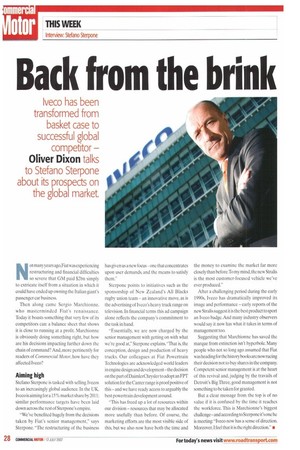Back from the brink
Page 28

If you've noticed an error in this article please click here to report it so we can fix it.
Iveco has been transformed from basket case to successful global
competitor —
Oliver Dixon talks to Stefano Sterpone about its prospecs on the global market.
Not many years ago,Fiat was experiencing restructuring and financial difficulties so severe that GM paid $2bn simply to extricate itself from a situation in which it could have ended up owning the Italian giant's passenger ear business.
Then along came Sergio Marchionne, who masterminded Fiat's renaissance. Today it boasts something that very few of its competitors can: a balance sheet that shows it is close to running at a profit. Marchionne is obviously doing something right, but how are his decisions impacting further down the chain of command? And, more pertinently for readers of Commercial Motor, how have they affected Iveco?
Aiming high
Stefano Sterpone is tasked with selling Ivecos to an increasingly global audience. In the UK. Iveco is aiming for a 15% market share by 2011; similar performance targets have been laid down across the rest of Sterpone's empire.
"We've benefited hugely from the decisions taken by Fiat's senior management," says Sterpone. "The restructuring of the business has given us a new focus— one that concentrates upon user demands, and the means to satisfy them."
Sterpone points to initiatives such as the sponsorship of New Zealand's All Blacks rugby union team — an innovative move, as is the advertising of Iveco's heavy truck range on television. In financial terms this ad campaign alone reflects the company's commitment to the task in hand.
"Essentially, we are now charged by the senior management with getting on with what we're good at," Sterpone explains. "That is, the conception, design and production of heavy trucks. Our colleagues at Fiat Powertrain Technologies are acknowledged world leaders in engine design and development—the decision on the part of DaimlerChrysler to adopt an FPT solution for the Canter range is proof positive of this — and we have ready access to arguably the best powertrain development around.
"This has freed up a lot of resources within our division — resources that may be allocated more usefully than before. Of course, the marketing efforts are the most visible side of this, but we also now have both the time and the money to examine the market far more closely than before.To my mind, the new Stralis is the most customer-focused vehicle we've ever produced."
After a challenging period during the early 1990s, Iveco has dramatically improved its image and performance — early reports of the new Stralis suggest it is the best product to sport an Iveco badge. And many industry observers would say it now has what it takes in terms of management too.
Suggesting that Marchionne has saved the marque from extinction isn't hyperbole. Many people who not so long ago assumed that Fiat was heading for the history books are now rueing their decision not to buy shares in the company. Competent senior management is at the heart of this revival and, judging by the travails of Detroit's Big Three, good management is not something to be taken for granted.
But a clear message from the top is of no value if it is confused by the time it reaches the workforce. This is Marchionne's biggest challenge—and according to Sterpone it's one he is meeting: "Iveco now has a sense of direction. Moreover, I feel that it is the right direction." •
























































































































































































